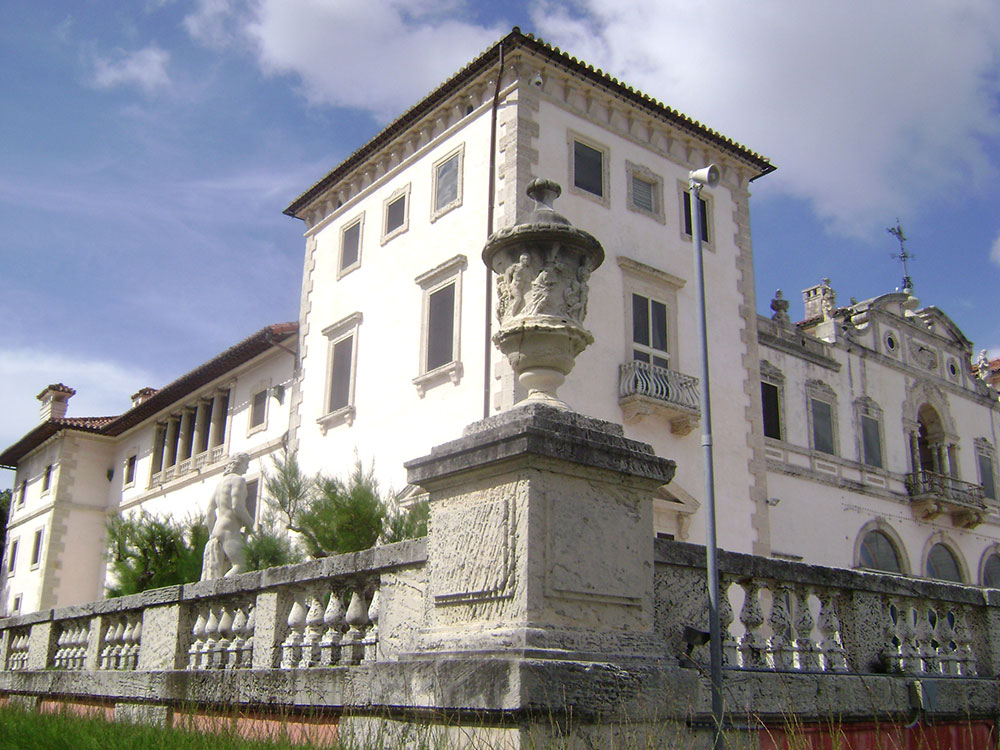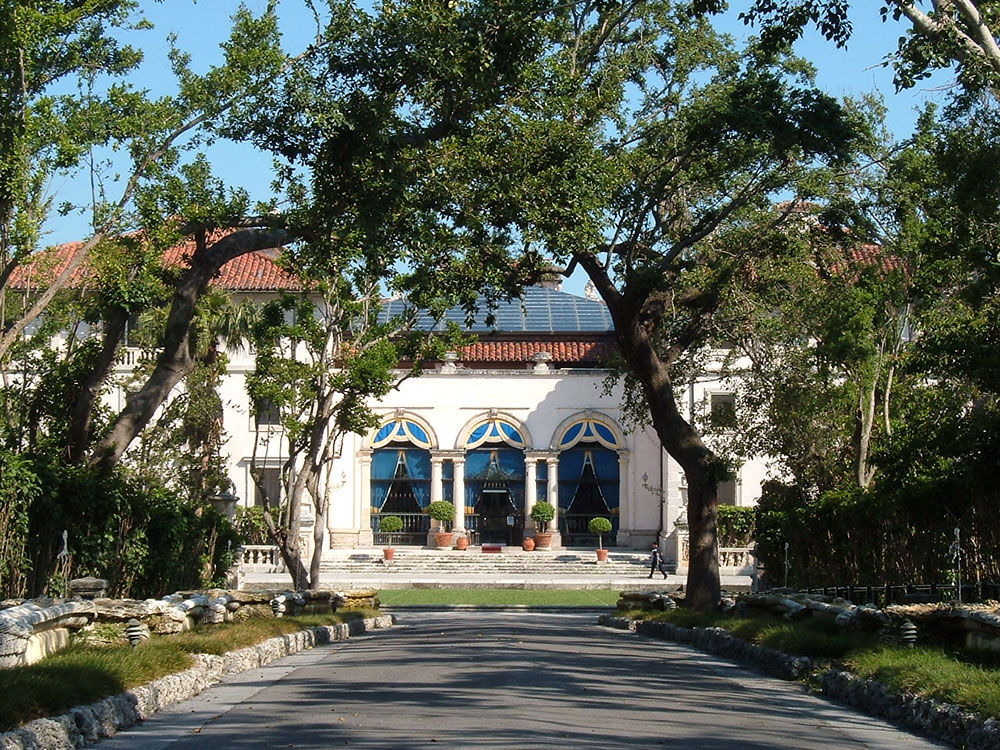Former villa and estate of businessman James Deering, on Biscayne Bay, that includes extensive Italian Renaissance gardens, native woodland landscape, and a historic village outbuildings compound
General Information
Child (6-12): $10.00
Children (5 and under): Free
How to Get There
Overview
The Vizcaya Museum and Gardens, previously known as Villa Vizcaya, is the former villa and estate of businessman James Deering, of the Deering McCormick-International Harvester fortune, on Biscayne Bay in the present day Coconut Grove neighborhood of Miami, Florida. The early 20th century Vizcaya estate also includes: extensive Italian Renaissance gardens; native woodland landscape; and a historic village outbuildings compound.
The landscape and architecture were influenced by Veneto and Tuscan Italian Renaissance models and designed in the Mediterranean Revival architecture style, with Baroque elements. F. Burrall Hoffman was the architect, Paul Chalfin was the design director, and Diego Suarez was the landscape architect.
-1000.jpg)
Miami-Dade County now owns the Vizcaya property, as the Vizcaya Museum and Gardens, which is open to the public.
The estate's name refers to the northern Spanish province Vizcaya (In English Biscay), in the Basque region along the east Atlantic's Bay of Biscay, as 'Vizcaya' is on the west Atlantic's Biscayne Bay. Deering used the Caravel, a type of ship style used during the 'Age of Exploration', as the symbol and emblem of Vizcaya. A representation of the mythical explorer "Bel Vizcaya" welcomes visitors at the entrance to the property.
The estate property originally consisted of 180 acres (73 ha) of shoreline Mangrove swamps and dense inland native tropical forests. Being a conservationist, Deering sited the development of the estate portion along the shore to conserve the forests. This portion was to include the villa, formal gardens, recreational amenities, expansive lagoon gardens with new islets, potager and grazing fields, and a village services compound. Deering began construction of Vizcaya in 1912 officially beginning occupancy on Christmas Day 1916 when he arrived aboard his yacht Nepenthe.
The villa was built primarily between 1914 and 1922, at a cost of $15 million. Deering used Vizcaya as his winter residence from 1916 until his death in 1925. While the construction of the extensive elaborate Italian Renaissance gardens and the village continued into 1923. During the World War I years building trades and supplies were difficult to acquire in Florida. Vizcaya is noteworthy for adapting historical European aesthetic traditions to South Florida's subtropical ecoregion. For example; it combined imported French and Italian garden layouts and elements implemented in Cuban limestone stonework with Floridian coral architectural trim and planted with sub-tropic compatible and native plants that thrived in the habitat and climate. Palms and Philodendrons had not been represented in the emulated gardens of Tuscany or Île-de-France.
In 1910, interior decorator Elsie de Wolfe introduced Deering to Paul Chalfin, a former art curator, painter, and interior designer, who became the project's director. He assisted and encouraged Deering to collect art items, antiquities, and architectural elements for the project. Chalfin recommended the architect F. Burrall Hoffman to design the structure and facade of the villa, garden pavilions, and estate outbuildings.
In 1914, during a visit to Villa La Pietra in Florence, Deering and Chalfin met Colombian landscape designer Diego Suarez. Suarez, the designer of the landscape master plan and individual gardens, trained with Sir Harold Acton at the gardens of Villa La Pietra outside Florence, Italy.
Vizcaya's villa exterior and garden architecture is a composite of different Italian Renaissance villas and gardens, with French Renaissance parterre features, based on visits and research by Chalfin, Deering, and Hoffman. The villa facade's primary influence is the Villa Rezzonico (it) designed by Baldassarre Longhena at Bassano del Grappa in the Veneto region of northern Italy. It is referred to sometimes as the "Hearst Castle of the East".
James Deering died in September 1925, on board the steamship SS City of Paris en route back to the United States. After his death Vizcaya was inherited by his two nieces, Marion Deering McCormick, wife of Chauncey McCormick, and Barbara Deering Danielson, wife of Richard Ely Danielson. Over the decades, after hurricanes and increasing maintenance costs, they began selling the estate's surrounding land parcels and outer gardens. In 1945 they sold significant portions of the Vizcaya property to the Catholic Diocese of St. Augustine, Florida, to build Miami's Mercy Hospital. 50 acres (200,000 m2) comprising the main house, the formal gardens, and the village were retained.
In 1952 Miami-Dade County acquired the villa and formal Italian gardens, needing significant restoration, for $1 million. Deering's heirs donated the villa's furnishings and antiquities to the County-Museum. Vizcaya began operation in 1953 as the Dade County Art Museum. The village and remaining property were acquired by the County during the mid-1950s. In 1994 the Vizcaya estate was designated as a National Historic Landmark. In 1998, in conjunction with Vizcaya's reaccreditation process by the American Alliance of Museums, the Vizcaya Museum and Gardens Trust was formed to be the museum's governing body.
The Estate is now known officially as the Vizcaya Museum and Gardens, which consists of 50 acres (200,000 m2) with the villa and the gardens, and the remaining native forest. The estate is a total of 50 acres (200,000 m2), of which 10 acres (40,000 m2) contain the Italian Renaissance formal gardens, and 40 acres (160,000 m2) are circulation and the native 'hammock' (jungle forest).
The villa's museum contains more than seventy rooms of distinctive architectural interiors decorated with numerous antiques, with an emphasis on 15th through early 19th century European decorative art and furnishings. Amongst those furnishings contain ceramics, the originals of which were shipped from England in 1912 but sank along with the Titanic
This article uses material from the Wikipedia article "Vizcaya Museum and Gardens" which is released under the Creative Commons Attribution-Share-Alike License 3.0
-1000.jpg)

